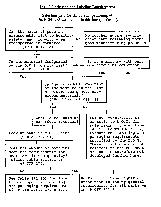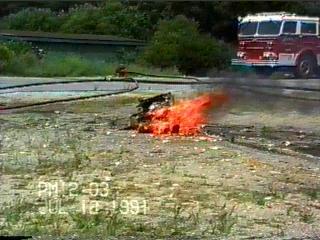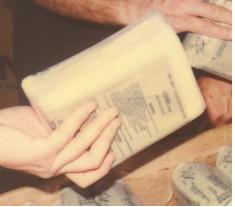Chemical Safety
Our work in this market focuses on fires, explosions and toxic releases due to accidents, malfunctions, and intentional attacks involving materials, processes, equipment and operations. We provide software, safety assessment services and assistance in identifying strategies/developing technologies to prevent unsafe conditions and protect against them, if they do occur. We provided these services to various government and industry clients working in aircraft, environmental services, weapons research, chemical and petrochemical processing, energy, manufacturing, nuclear and nanotechnology areas.
- Software
- Hardware/Instrumentation:
- Case Studies:
- Hydrogen Safety
- Safety of Equipment used to vent/sample gases from nuclear waste drums
- Shock sensitive materials
- Flameless ration heater
- Pipeline hazard
- Industrial facility hazards
- Fault Tree Analysis
- Quantitative Risk Assessments
- Rocket Launch Risk Assessment and Acceptability Analysis
- Bunkering Operations
- Fire Scenarios for Rail Transport of Radioactive Waste
- Fires in Rapid Transit Systems
- Risk Analysis Studies
Hydrogen Safety
Deflagration and Detonation of Hydrogen
After the Three Mile Island accident, EPRI invited Dr. Moussa along with a few other hydrogen fire experts to help them plan a program on hydrogen safety. We evaluated the burning character of hydrogen bubble inside the reactor including the potential for deflagration and detonation. A quarter scale model of a reactor sector was selected to test in-situ fires under controlled conditions.
Comparison of Industrial Transportation Methods
For DOT, we compared "quantitatively" the risks associated with Expandable Launch Vehicles to a variety of "common" industrial and transportation activities. The analysis covered handling, transport, storage and launch operations of liquid hydrogen/oxygen, RP-1, hypergolics and solid propellants. The frequency and consequences of potential accidents were compared with historical accidents for the release of hazardous materials.
Fire Hazards of a Liquid Hydrogen Aircraft
For NASA Lewis, we analyzed the relative crash hazards of supersonic commercial aircraft fueled by liquid hydrogen and methane, and Jet A. We modeled impact-survivable post crash scenarios resulting in pool fires, fireballs or explosions. For each fuel we compared the hazard zone for each scenario and its impact on the aircraft.
Rocket Launch Hazards Modeling
For the commercial space program, BlazeTech modeled the fire, explosion, and toxic dispersion associated with accidental releases of propellants during pre-launch and launch operations for hazards. We examined liquid and solid rocket motors, and hybrid engines in the Atlas-Centaur, Titan, Delta, and AMROC systems. The propellants included liquid oxygen and hydrogen, hydrazine compounds and nitrogen tetroxide. The analysis covered handling, transportation, storage and launch operations of liquid and solid propellants. To determine risk acceptability, the frequency and consequences of potential accidents were compared with historical data for hazardous materials associated with more common activities such as industrial and transportation accidents.
Safety of Equipment used to vent/sample gases from nuclear waste drums
For a DOE Lab, we examined the safety of a Drum Venting System (DVS) that vents drums containing legacy nuclear waste. The nuclear waste undergoes chemical reactions inside the closed drum producing flammable chemicals such as hydrogen. For various geometries of the drum, venting cabinet and glove box as well as the initial drum conditions (composition, temperature and pressure), we examined the following:
- The potential for the development of flammable conditions in the drum.
- Potential for explosion in the drum, drum failure and expansion of explosion products into the surrounding cabinet and pressure rise in the cabinet.
- Effect of pressure rise in the cabinet on various components such as the glove box, filters and vent systems.
- Potential for a Deflagration to Detonation Transition (or DDT).
Also, we reviewed the DOE Standard (DOE-STD-5506-2007, April, 2007) on the “Preparation of Safety Basis Documents for TransURanic (TRU) Waste Facilities.“
Deflagration of Shock Sensitive Chemicals
BlazeTech is currently developing an engineering model to calculate the hazards associated with the combustion/deflagration of shock sensitive chemicals. A number of common laboratory chemicals are prone to forming explosive organic peroxide upon storage for extended periods. Examples include ether, tetra hydro furan (THF), and acetaldehyde. The model calculates the overpressure, fragmentation of container and fire hazards associated with the combustion/ deflagration of lab quantity chemicals containing variable amounts of peroxides.
A Food Heating Device Based On the Hyper-Corrosion of a Magnesium-Iron Alloy
A Pack of Flameless Ration Heaters
BlazeTech contributed to the development of the Flameless Ration Heater (FRH), a food heating device based on the hypercorrosion of a magnesium-iron alloy. In 1991, the FRH was selected by Research and Development Magazine's "R&D 100 Awards Com- petition" as one of the top 100 most significant techincal products of 1990. The FRH is currently packaged with every Meal, Ready-to-Eat (MRE), providing U.S. troops with hot meals in the field.

A simple flowchart was developed by BlazeTech to demistify the complex federal regulations for packaging and labeling of transported hazardous material. Information for re-writing the MSDS was compiled from tests described below.
(Click here to access the DOT packaging and labeling requirements.)
Fire And Explosion Hazard Data
Unusual Fire And Explosion Hazards
If a case of Flameless Ration Heaters is ignited, the cardboard and the plastic (polyethylene) pouch will burn initially as a class A fire. If this fire is allowed to burn for more than a few minutes, the following additional hazards arise:
- Flare of magnesium powder with water
- Click picture to watch a 616KB MPEG Movie
Magnesium powder ignites and burns as a class D fire -- exhibiting sparking and flare up if sprayed with water. The production of hydrogen is possible.
The plastic pouch containing the FRH pad melts, potentially exposing the FRH to water from attempted fire fighting. This water may activate the FRH and produce hydrogen (up to a maximum of a 1/3 cu. ft. per pad).
Special Fire Fighting Procedure
In the early phase of a fire, when only the cardboard and the plastic are involved, the fire can be fought with conventional suppression agents intended for class A fires. This requires very early detection and suppression of the fire before the involvement of magnesium or the production of significant amounts of hydrogen.
Firemen produce water fog curtain to shield themselves from the hear of a fire Click picture to watch a 616KB MPEG Movie
Firemen produce water fog curtain to shield themselves from the heat of a fire.
If the addition of a fire fighting agent intensifies the reaction (which suggests magnesium has become involved), fire fighting operation with water should be immediately stopped.
If the FRH continues to smoke or sizzle after the flames are out, hydrogen is being produced. The addition of water, if indoors, should be stopped since it can increase hydrogen generation.
If it is possible to do so safely, a small indoor fire should be moved outdoors and allowed to burn out. Caution should be exercised while moving it such that burning magnesium particles do not drip out and produce a trail of fire. Once safely outdoors, spreading the contents of the case will attenuate a magnesium fire, but caution should be exercised to prevent burning magnesium particles from being carried by the wind as firebrands. Provided there are no nearby sources of ignition, the fire may then be thoroughly drenched with water. Otherwise, allow the burned material to drain and dry out to reduce hydrogen generation.
Overall fire behavior is insidious and may startle or deceive fire fighters. Fire fighters should be informed of the potential fire behavior to enable them to take proper actions.
Extinguishing Media

In the early phase (i.e. when a case of FRH burns as a Class A fire), water, carbon dioxide, and foam may be used
If the magnesium becomes involved, none of these agents will work very well and some (particularly water) may cause the fire to flare up. FRHs should be allowed to burn to completion, wherever safely possible.
Precautions For Safe Handling And Use
Steps to be Taken in Case Material is Released or Spilled
Collect spilled FRHs and inspect the integrity of the plastic pouches to protect against water penetration into their interior:
- If breached (such as by tears, cracks, punctures, even as small as pinholes), then dry and dispose of as waste as described below.
- If the pouches are not breached, then dry and repackage.
Waste Disposal Method
Reacted (used) FRHs may be disposed as ordinary waste. Unreacted (unused) FRHs may:
- Be opened and reacted with water in accordance with the instructions on the label, then disposed of as ordinary waste, or
- Be incinerated or reacted by an approved hazardous waste disposal facility.
Unreacted (unused) FRHs which have been damaged by having the polyethylene pouches punctured or torn should be disposed as above as quickly as possible to ensure they are not accidentally exposed to water.
Precaution to be Taken in Handling and Storage
Warehouses where large quantities of FRH pallets are stored should provide the following protection:
- Protection against physical damage of the cases.
- Protection from water in any form, including leaks, snow, rain, or flooding. Damaged cases should be handled with particular care since they are more vulnerable to activation by water.
- Protection against sources of ignition.
- Early fire suppression which is essential to prevent the formation of a difficult to suppress magnesium fire. This also prevents breaching the integrity of the plastic pouches that protect the FRH from activation by fire fighting water.
- Equipment for fighting Class A and Class D fires should be available.
- Proper ventilation should be provided so that hydrogen will not build-up in confined spaces should it be generated.
- Training of the local fire service in fighting combined Class A and Class D FRH fires.
- Complete burn-out of the fire should be planned for if early suppression is unsuccessful.
Locations where small quantities of FRHs are stored (such as one or two pallets in a distribution center) should ensure the same protective measures as for large quantities, except that complete burn-out may be replaced by safe movement of the pallet outdoors.
During transportation, the same protection as described above for storage should be followed except that the described fire suppression equipment are not likely to be present. In such cases, the material should be off-loaded to the outdoors and allowed to burn-out as described above. Appropriate warning labels should be placed on the exterior of the case and should be visible when cases are stacked on a pallet regardless of case orientation.
Hazard Assessment for Property Surrounding Pipelines Carrying Flammable Gases
We recently performed an analysis of the possible fire and explosion hazards resulting from breakage of a pipeline carrying flammable gas under pressure and the potential threat to the property surrounding it. The breakage may be accidental or intentional (for example, due to terrorist activity). If the pipeline breaks, it takes a finite time for the gas supply to the pipeline to be shut off. During this time, a large amount of flammable content may leak out of the pipe. Ignition of leaked flammable gas may cause property damage and collateral loss.
We recently analyzed possible fire and explosion hazards associated with the breakage of a natural gas pipeline and its effect on the neighborhood structures such as bridges, plants and buildings. As a part of this analysis, we answered the following questions:
How much natural gas will be released?
Is the natural gas plume flammable?
Can the natural gas plume ignite?
What type of fire can result when the gas is unconfined?
What are the potential catastrophic effects of a long duration fire (say 1 hour)?
Can the natural gas explode?
This analysis can be extended easily to predict the hazard associated with other pipelines and storage tanks carrying flammable content.
Fire and Explosion in Industrial Facilities
Most petroleum, petrochemical and chemical processing companies contain large amounts of flammable and toxic materials. These pose various types of fire and explosion hazards such as:
- Pool fire
- Boiling Liquid Expanding Vapor Explosion (BLEVE)
- Vapor Cloud Explosion (VCE)
- Flash fire
- Jet fire
- Vapor blow-down
Any combination of the above events occur in industry depending on the initiation type, chemicals involved and the strength of the storage tanks.
We have gained years of experience in these areas through government contracts and commercial projects. We developed engineering models for the above release scenarios encapsulating the most up to date calculation methods as well as our expertise. We provide consulting services based on these models to investigate such occurrences.
Fault Tree Analysis
For a major import terminal, we estimated the probability of overpressurizing an LNG tank. Using fault-tree analysis, this probability was related to the failure rates of individual components (such as relief valves and pressure sensors) and to operator errors. Thus, we identified likely failure modes and means to mitigate them.
Quantitative Risk Assessments
For a number of commercial clients, we carried out risk analyses of the processing, storage and shipments of oil/LNG/LPG and various hazardous materials. For example we used fault tree analysis to relate the probability for overfilling an LNG tanker truck to the failure rates of equipment such as level gages, pressure sensors (etc.) and to operator errors. Also, we used modeling to characterize the consequence of a range of fire and explosion accidents including fire and explosion and the thermal or overpressure fields surrounding them that lead to damage. We calculated the hazard zones for thermal damage, building collapse, window breakage, etc.
Rocket Launch Risk Assessment and Acceptability Analysis
For the commercial space program, we modeled the fire, explosion, and toxic dispersion for hazards associated with accidental releases of propellants during pre-launch and launch operations. We examined liquid and solid rocket motors, and hybrid engines in the Atlas-Centaur, Titan, Delta and AMROC systems. The propellants included liquid oxygen and hydrogen, hydrazine compounds and nitrogen tetroxide. The analysis covered handling, transportation, storage and launch operations of liquid and solid propellants. To determine risk acceptability, the frequency and consequences of potential accidents were compared with historical data for hazardous materials associated with more common activities such as industrial and transportation accidents.
Bunkering Operations
For Saudi Arabia's government, we surveyed the safety and pollution needs and practices of the bunkering industry. This included the inspection of on-shore hydrants, barges and off-shore platforms. We reviewed their designs, operating procedures, fire mitigation systems, and emergency plans, and outlined guidelines for their operation and monitoring.
Fire Scenarios for Rail Transport of Radioactive Waste
For the rail transport of radioactive waste, we outlined design fire scenarios that should be withstood by the cask. We based them on a review of historical accidents, hypothetical scenarios and the requirements for other rail cars. We analyzed the thermal response of the cask to assess structural integrity over the fire durations.
Fires in Rapid Transit Systems
For a major US transit authority, we modeled the growth of an undercar fire. The burning rate was assumed to follow a power law involved initially the polyurethane insulation in the wall cavity, then the melamine panels, then the remaining combustible materials in the car. Two flow fields were analyzed. First, a fire-induced two-layer system with products of combustion moving away from the fire at the top layer, and fresh. air moving towards the fire at the bottom. Second, a ventilation fan-induced (forced convection) flow field consisting of a single plug flow-type gas layer which contained initially fresh air, but then, as it passed over the fire zone, it carried along the products of combustion. For each flow field, the build-up of smoke and heat was estimated as a function of time at various locations inside the tunnel--until lethal conditions were reached.
Risk Analysis Studies
For a number of commercial clients, we carried out risk analysis studies covering oil/LNG/LPG operations, and shipments of hazardous materials by various transportation systems. These studies consisted of four elements. First, we identified the major types of accidents and their qualitative features. Second, we estimated the probability of these accidents using fault-tree analysis. Third, we quantified the consequences of the accidents in terms of fire, BLEVEs, explosion, dispersion and the hazard distance in each case. Forth, we developed risk profiles that integrated probability and severity and allowed us to evaluate various mitigation options.

